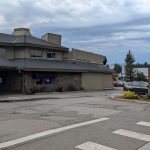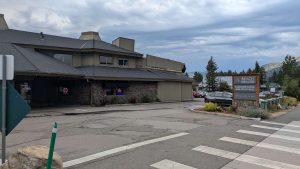Aging houses and expensive repairs: how Tahoe’s housing quality shapes up
LAKE TAHOE, Calif./Nev. – According to data from the U.S. Census Bureau, on average, over half of the homes around the Tahoe Basin were built before 1979. While age isn’t the only determining factor in housing quality, the reality is that many housing options are subject to the changes of the decades: years of weather damage, broken-down facilities, and inadequate repairs that can make a home far more difficult to live in.
Add in changing regulatory standards, higher expenses and the challenges of those who address housing quality and it’s easy to see why these problems go untouched. But leaving it alone leaves a lot of suffering in its wake, and the problem won’t go away on its own—in fact, it’ll probably get worse.
In this article of the Tribune’s ongoing housing series, we’re looking at a problem that affects people already living in the area and how it impacts quality of life.
What are the markers of substandard housing?
The National Center for Healthy Housing reports that approximately 45 million metropolitan homes in the U.S. have health and safety hazards that can cause significant illness, injury and death to their residents. The characteristics they measure in their reports are:
- Holes in floors
- Open cracks or holes in the interior
- Broken plaster and peeling paint
- Signs of pests (rodents, insect infestations, etc.)
- Water leakage in the last 12 months
- Water supply stoppage
- Flush toilet and flush toilet breakdowns
- Sewage disposal breakdown
- Lacking complete plumbing
- Heating equipment breakdown
- Room heater without a flue/vent/chimney
- Exposed wiring in unit
- Rooms without working electric wall outlets
- Lacking kitchen facilities
- Roofing problems
- Siding problems
- Window problems
- Foundation problems
Housing quality connects with the goals of preserving the housing stock for seniors and the workforce is a key part of several long-term plans, along with maintaining quality of life for residents.
There are region-specific concerns that exacerbate the decline in housing quality. The region’s weather, age of homes and type of homes have major impacts. Winters can cause damage to roofs, pipes and windows, which can lead to costly repairs that are often deferred. And many of the homes, which were built before the eighties, were designed as summer cottages—they’re smaller designs, not weatherized and have often sustained years of damage.
Bethany Drysdale, media and communications officer for Washoe County, indicated that the planning department has thought about housing quality, but it’s difficult to measure.
“Housing stock quality was a topic during the master plan update because we tried to investigate it. But it gets complicated when you try to turn the age of housing into useful information. It can only be used to make inferences and assumptions about the actual quality of the individual units,” said the planning department via an email from Drysdale.
Erin Casey of the Tahoe Housing Hub also cautioned against using age as the only indicator. “Some of the older houses are built with different materials and have stood the test of time, while some newer ones can have issues. There are a lot of differing factors.”
Still, age can contribute to these issues—below is a table of the housing stock built before 1979 and current data on homes without kitchens or plumbing.

These statistics are broadly more representative of single-family homes, as building multi-family housing occurred in more recent years. But these data don’t necessarily reflect changes in use of those houses (possibly being rented rather than owned) and removal of these houses from the stock. It also doesn’t reflect the proportion of mobile homes, which also suffer from substandard housing issues.
While there are scattered datapoints about these living conditions, people living in them are subject to a landlord or property manager’s decision to address the issues—and frequently worry about retaliation if they do report what’s happening.
Substandard housing hotline
There’s only one place in the Tahoe Basin that has a supported substandard housing hotline—the city of South Lake Tahoe. While North Shore and Truckee have the support of the Sierra Community House hotline for tenants and landlords, other parts of the Tahoe Basin don’t have a single clear place to go to for help.
Staff report that they’ve received calls from people all around the lake asking for help. But they only have the power within city limits to address issues.
The hotline was established in 2002 by the city council, staff, and other local agencies and partners to address complaints about the housing quality in the city. Common complaints included mold and water intrusion, lack of heat and civil complaints—which the staff are not technically meant to address through the hotline services. However, they do provide civil resources for both tenants and landlords in accordance with laws in the state of California.
As of early August 2025, the hotline received 26 complaints, which is far less than the thousands they used to receive. This is in part due to the Multi-Family Dwelling (MFD) Inspection program, which covers single room occupancies (SROs) and identifies blighted and deteriorating housing stock.
Still, for renters in apartments with less than six units or sharing a residence not covered by the MFD, the hotline is one of the more reliable ways to ensure inspection and resolution happen.
To fix substandard housing issues, a resident must fill out a form and affidavit, along with providing proof that there was an attempt to resolve the issue. The city schedules inspections and prioritizes more severe issues, such as a lack of heating in winter or no plumbing. During the inspection, they then provide the property owner with a list of found violations, required corrections and a deadline to complete the corrections by.
Further enforcement occurs if the property owner doesn’t meet the deadline—there’s a substandard housing fee of $656 and a reinspection fee of $177. The city tries to work with property owners, especially those who own multiple properties, to ensure that fixes happen in a timely manner. But it’s a complex issue.
Who is affected?
Substandard housing quality particularly affects vulnerable populations like children, seniors and disabled people, and puts financial strain on those who try to fix these issues. It also tends to affect marginalized communities who face a variety of housing struggles.
SROs that are poor quality are often “housing of last resort”, which means there are no other options besides homelessness. People who live there may be trying to transition to better housing, but can get stuck in a place that is affordable to them and at least keeps them off the streets.
Seniors and disabled people with a fixed income may be displaced from their homes after rents are raised, then forced to find housing that can be inadequate for their needs. Issues like holes in the floor or lack of heat can also lead to injuries that are far harder to recover from.
J-1s and other seasonal workers may put up with poor housing quality since they’re only in town for a few months. Some have spoken about severe pest and mold issues, but can’t report them for remediation because it will remove them from their housing.
Others who want to work and live in the area might struggle to support themselves while looking for a place to stay permanently.
Vivienne Olsen said she used to commute from Placerville to her job in South Lake Tahoe, but between gas expenses and other financial hardships, it was hard to make enough to put down a security deposit. She was offered a place to stay that didn’t have electricity or hot water in the middle of winter, then was asked to leave due to a miscommunication from the property owner. “It just wasn’t worth it,” said Olsen, who has now moved to Sacramento for a new job and more stable housing.
Connection with affordable housing
“Substandard housing affects the way that people live, especially from a very young age. Going to school cold or without showers creates a stress level for kids and parents,” said Lydia Zuniga, associate management analyst in the city’s housing division. “But at the same time, do we want people living in the woods or their car? Or do people want a roof over their heads, even if it’s substandard housing? You have to pick and choose.”
Because the reality is that making these repairs doesn’t happen for a variety of reasons. For many properties in the basin, Zuniga says that there are absentee landlords who don’t live nearby and don’t see how bad it can be. Other times, the repairs themselves can be prohibitively expensive. When a property is rehabilitated, it has to comply with current building codes, meaning there may be even more repairs to be made than meets the eye.
One example of this was 933 Poplar Avenue, which has now become Desolation Hotel. But before it was sold and demolished, Zuniga says, “The property was horrific.” Like the torn-down Sunray Motel, people often live in these properties as SROs—but they can come with a myriad of issues like lack of water, electricity, broken windows and railings. But by tagging the building, it could displace those living there.
“Sometimes it’s easier to just tear down a property than to rehab it,” said housing manager Jessica Wackenhut Lomeli. “We have discretion at the staff level when we respond to complaints, because sometimes it’s worth it for a tenant to live with the issue until they can get more secure housing.”
Fear of retaliation
In its housing element, the city addresses both preservation of housing and new construction to tackle the housing crisis. Part of that is because older housing represents “naturally affordable housing”, a needed component for those who may not qualify for income-restricted housing like Sugar Pine Village or the Aspens.
Property managers in the basin have said that age and condition can have an effect on the rent pricing, where older buildings with little to no improvements are typically priced on the lower end.
But egregious issues do pop up in these properties, which can trap people in substandard housing. The pricing is low because there are underlying, unresolved issues, and when they arise, tenants worry about reporting them and losing a place they can afford. Without people to call or a system to formally address these issues, they fall through the cracks and continue to live in poor-quality housing.
In Washoe County’s Local Employee Housing Needs and Opportunities study, 45% of respondents who lived in Washoe County said they were unsatisfied with their housing because it needed repairs or was in poor condition. 54% of those who needed repairs said it was because their landlord did not take responsibility.
One anonymous response read, “If we ask the landlords to fix and/or improve things, they will charge us for it or continue to raise our rent,” then detailed water damage, mold, electrical issues and a dilapidated deck. “We know our rent will skyrocket if (the deck is replaced). We invest a lot of our own time and money into things we can fix… because we do not want the landlords to use it against us.”
“Civil issues are often intertwined with these substandard housing issues,” said Wackenhut Lomeli. “That’s part of what makes this so complex.”
Major expenses
While it’s expensive for tenants to make these repairs, landlords and property owners don’t get off easy on cost either. The price for rehabilitation can often match that of new construction at roughly $350 to $650 per square foot.
The Redevelopment Agency used to maintain funds for housing repairs, but the agency was dissolved in 2012 and since then, cities and agencies have had to apply for extremely competitive grants.
Last year, South Lake Tahoe applied for a grant that would fund loans to repair homes, but didn’t receive the grant. Truckee similarly has been looking into funding options for home repair, but where federal funds are in high demand, local funding options just aren’t there.
So, deferring these repairs becomes the default: patch things up enough to make it livable, then repair it if there’s enough money. Beyond the clear problem of kicking the can down the road, it can also make it impossible to get funding when damage happens for other reasons.
During the winter storms of 2023 which were declared a state emergency, FEMA funds were distributed to make repairs. However, they weren’t distributed to houses that had deferred maintenance, because it was impossible to tell what had been caused by the storm—compounding the future prices for getting problems fixed.
These repairs and home changes are also necessary for making places accessible, which serves disabled people and aging in place. But the price can make it difficult to install ramps, ADA compliant counters and other measures that would majorly improve quality of life.
Developing solutions
While housing quality ties into bigger goals for the region, it’s not currently a top priority for most of the basin. But some solutions exist, or are in development, that target these issues.
Inspection programs are one of the ways that make it possible for substandard housing to be addressed, but these programs and other means of inspection currently require some sort of report to be filed.
Other services like the mediation offered by Sierra Community House can help with tenant and landlord civil issues, which can also resolve fears of retaliation and get those parties in contact with each other.
While local funding isn’t present for repair loans, other funding methods could bring in more money.
Continuing to apply for competitive state and federal grants is a necessary part of the process. For example, Nevada County just received funding from the Manufactured Housing Opportunity and Revitalization program through the California Department of Housing and Community Development (HCD). It provides funding to repair or replace manufactured and mobile homes for lower-income homeowners in Nevada County’s mobile home parks.
In a Nevada County press release, housing manager for Housing and Community Services Eric Zibbel said, “Manufactured and mobile homes are an important source of affordable housing, but they often have deferred maintenance or aging infrastructure to address. With this program, homeowners can get the repairs they need and remain in their homes.”
Other methods like seeking money from initiatives like home hardening, electrification or other green energy upgrades could be combined with addressing substandard housing conditions. Nevada County’s MORE application specifies that other qualifying repairs include accessibility or energy upgrades.
Recently, in efforts for protecting and preserving workforce housing, Tahoe Housing Hub has been working on a program to either buy or receive properties, then manage and maintain them in order to keep prices affordable for local workers.
As CEO and president of the Tahoe Housing Hub Erin Casey puts it, “There’s a need to intervene with rentals being sold. I’m not saying it happens every day, but it’s true that properties are bought up, rents are raised and people are displaced. So how do we protect what little of the housing that we have?”
Casey emphasized that fixing substandard housing quality is a part of their upcoming business model, as well as adding a nonprofit 501(c)(3) aspect to the Tahoe Housing Hub.
As the housing stock continues to age and change throughout the basin, housing quality is one of the metrics that needs to be a part of housing conversations to ensure safe living conditions for many more years—and residents—to come.
Eli Ramos is a reporter for Tahoe Daily Tribune. They are part of the 2024–26 cohort of California Local News Fellows through UC Berkeley.

Support Local Journalism

Support Local Journalism
Readers around the Lake Tahoe Basin and beyond make the Tahoe Tribune's work possible. Your financial contribution supports our efforts to deliver quality, locally relevant journalism.
Now more than ever, your support is critical to help us keep our community informed about the evolving coronavirus pandemic and the impact it is having locally. Every contribution, however large or small, will make a difference.
Your donation will help us continue to cover COVID-19 and our other vital local news.










